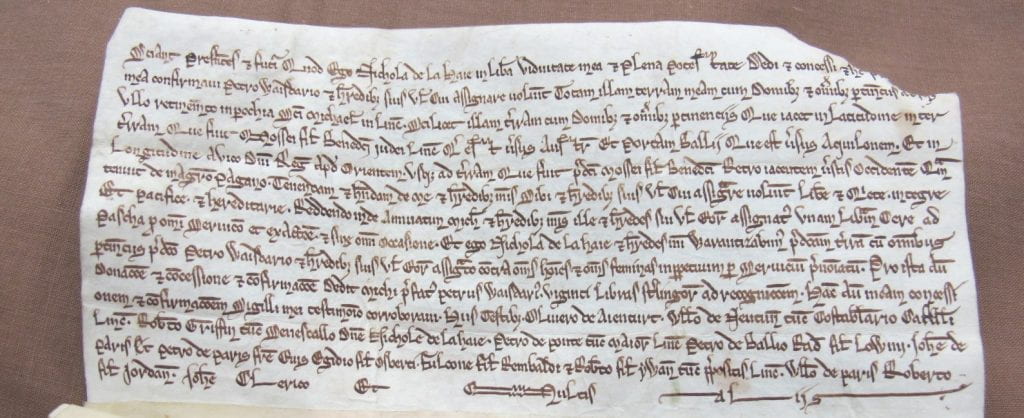In recent weeks, our Lincoln Record Society-funded PhD student, Jessica Holt, has been working with Dr Nicholas Bennett of the Lincoln Record Society, the University of Lincoln’s Conservation Team, Lincoln Cathedral and the Lincolnshire Archives. Using multi-spectral imaging, they have managed to recover lost text in the registers of Bishop Thomas Bek of Lincoln (1342-1347).
During the nineteenth century, canon G. G. Perry applied a chemical reagent to several folios from MS. 209, a late fourteenth-century manuscript held at the library at Lincoln Cathedral. (5) This manuscript contains one of the only two surviving copies of Richard Rolle’s Officium et Miracula. (8)Regrettably the chemical reagent caused irreparable damage and rendered some of its’ text illegible as evidenced in the image of f.3 r. below. Perry was later named and shamed for his deed in 1866 in an edition of the Early English Text Society. (3)

Image 1: Lincoln Cathedral, MS 209 f.3 r. with the kind permission of the Dean & Chapter of Lincoln Cathedral.
The challenge of trying to decipher faded court hand is not unfamiliar for those working directly with manuscripts. Whilst today, UV lamps can be used to combat this problem, researchers in the nineteenth century were forced to seek out another solution. (4) Several attempts were made using different chemical reagents to enhance the legibility of metallic inks. (1) Contrary to their original intent, however, these substances have now rendered many documents unreadable, as these substances later darkened, coating their original texts with dark brown, black, or, in some cases, blue staining. Of these chemical reagents the most common were:
- Tincture of Oak Gall (an alcohol-based tincture that utilises essence of oak galls)
- Sulphuric Tinctures (mixtures typically comprised of calcium carbonate, calcium polysulphide, and calcium sulphate)
- The ‘Giobert Tincture’ (mixture comprised of water, hydrochloric acid, and potassium hexacyanoferrate) (1)
Despite the clear damage these substances were causing to manuscripts across the course of the nineteenth century, these methods continued to be used as late as 1914, when Hugo Deunsing and Martin Flasher applied sulphuric tinctures to manuscripts stored in the library of the Orthodox Patriarchate in Jerusalem. (1)
Doctoral student, Jessica Holt, was forced to grapple with the damage caused by these chemical reagents when examining the registers of Bishop Thomas Bek of Lincoln (1342-1347). It quickly became apparent that several folios of register 6 had been damaged by an unknown nineteenth-century reagent. (6) Hope, however, laid with a technique known as multi-spectral imaging (MSI). MSI is a non-invasive scientific imaging technique that can be applied to manuscripts to recover lost text. (2, 7) This technique was also successfully used by the British Library in 2017 to recover script lost through fire damage, natural degradation, and chemical damage. (2) With the kind permission from the bishop of Lincoln, Lincoln Cathedral, and the Lincolnshire Archives, and the wonderful support of Claire Arrand, Dr Nicholas Bennett, and Professor Louise Wilkinson, we were able to transfer register 6 from the Lincolnshire Archives to the University of Lincoln, where we were able to use MSI to successfully recover the contents of the lost text with aid from Dr Philip Skipper and the conservation department.
Regrettably, unlike the damage caused to f.3 r. of MS. 209, the identity of the culprit has been lost to time. The positive results of MSI ultimately present an optimistic future for other researchers examining manuscripts similarly altered by nineteenth-century reagents.
*Jessica Holt is fortunate to have been awarded the Nigel Burn Memorial Postgraduate Studentship from the Lincoln Record Society to support her PhD.
References:
(1) Albrecht, Felix. ‘Between Boon and Bane: The use of Chemical Reagents in Palimpsest Research in the Nineteenth Century’, in M. J. Driscoll (ed.), Care and Conservation of Manuscripts 13 Proceedings of the Thirteenth International Seminar held at University of Copenhagen 13th-15th April 2001 (Brooklyn, 2012), 147-165.
(2) Duffy, Christina. ‘Multi-Spectral Imaging at the British Library’, 2018 3rd Digital Heritage International Congress (DigitalHERITAGE) held jointly with 2018 24th International Conference on Virtual Systems & Multimedia (VSMM 2018) (San Fransico, 2018), 1-4.
(3) English Prose Treatises of Richard Hampole, ed. G. G. Perry (1866).
(4) Kiernan, Kevin S. ‘The State of the “Beowulf” Manuscript 1882-1983)’, Anglo-Saxon England 13 (1984), 23-42.
(5) Lincoln Cathedral Library. MS. 209.
(6) Lincolnshire Archives. DIOC/REG/6-7b.
(7) Machain, Padriag O. ‘The Digitisation of Irish Manuscripts: Beyond and Beneath the Visible Image’, Studi Irlandesi 12 (2022), 43-56.
(8) The Officium and Miracula of Richard Rolle of Hampole, ed. Reginald Maxwell Wooley (Cornell, 1919).

